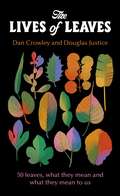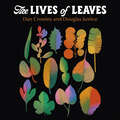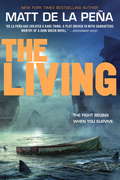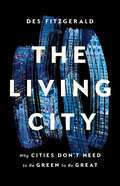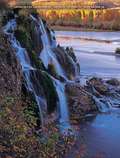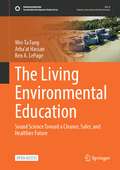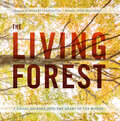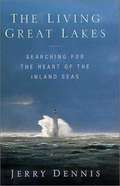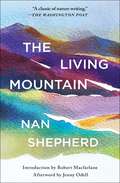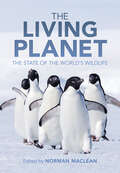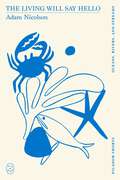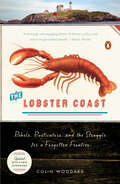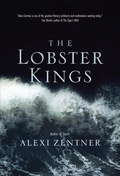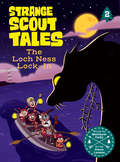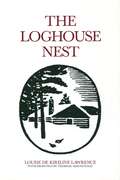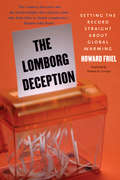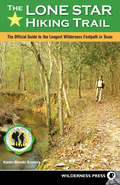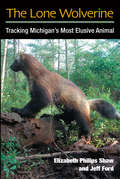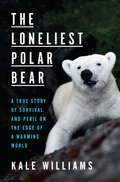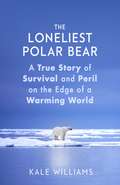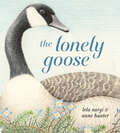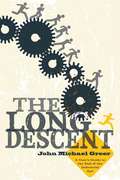- Table View
- List View
The Lives of Leaves: 50 Leaves, What they Mean, and What They Mean to Us
by Dan Crowley Douglas JusticeLeaves are one of nature's marvels. We watch them turn red in Autumn, make medicine from them, invent folklore around them, and mark the passing of time by them.But how do they grow? Why are they the shapes they are? What makes an evergreen, evergreen?The Lives of Leaves is a beautifully illustrated compendium of the tales, science and history of leaves from all around the world, from sugar maple and how leaves change colour, to gingko and the history and future of leaves as medicine. It's the story of what they do, what we do with them, and why we can't do without them.
The Lives of Leaves: 50 Leaves, What they Mean, and What They Mean to Us
by Dan Crowley Douglas JusticeThe secret stories of what leaves mean - and what they mean to us.Leaves are one of nature's marvels. We watch them turn red in Autumn, make medicine from them, invent folklore around them, and mark the passing of time by them.But how do they grow? Why are they the shapes they are? What makes an evergreen, evergreen?The Lives of Leaves is a beautiful compendium of the tales, science and history of leaves from all around the world, from sugar maple and how leaves change colour, to gingko and the history and future of leaves as medicine. It's the story of what they do, what we do with them, and why we can't do without them.(P) 2021 Hodder & Stoughton Limited
The Lives of Leaves: 50 Leaves, What they Mean, and What They Mean to Us
by Dan Crowley Douglas JusticeLeaves are one of nature's marvels. We watch them turn red in Autumn, make medicine from them, invent folklore around them, and mark the passing of time by them.But how do they grow? Why are they the shapes they are? What makes an evergreen, evergreen?The Lives of Leaves is a beautifully illustrated compendium of the tales, science and history of leaves from all around the world, from sugar maple and how leaves change colour, to gingko and the history and future of leaves as medicine. It's the story of what they do, what we do with them, and why we can't do without them.
The Living
by Matt de la Peña"De la Peña has created a rare thing: a plot-driven YA with characters worthy of a John Green novel."-Entertainment Weekly, A- "Action is first and foremost. . . . De la Peña can uncork delicate but vivid scenes." --The New York Times Shy took the summer job to make some money. In a few months on a luxury cruise liner, he'll rake in the tips and be able to help his mom and sister out with the bills. And how bad can it be? Bikinis, free food, maybe even a girl or two--every cruise has different passengers, after all. But everything changes when the Big One hits. Shy's only weeks out at sea when an earthquake more massive than ever before recorded hits California, and his life is forever changed. The earthquake is only the first disaster. Suddenly it's a fight to survive for those left living.More Praise for The Living: "[The Living] is special because of its extraordinary protagonist, Shy, who I haven't been able to shake from my mind in the weeks since I read the book."-John Green, author of The Fault in Our Stars"There's no way to classify The Living. It's everything I love mixed into one fantastic, relentless, action-packed story. As always with Matt, the characters are the best part. So real. I loved this book."-James Dashner, #1 New York Times bestselling author of the Maze Runner series[STAR] "An addictive page-turner and character-driven literary novel with broad appeal for fans of both."-Kirkus Reviews, Starred[STAR] "An excellent, enthralling ride...a great read for those looking for adventure and survival stories."-VOYA, Starred"De la Peña (I Will Save You) delivers near-constant action, a high body count, and a compelling cast of characters in this socially aware thriller."-Publishers Weekly"Peña takes the time to establish some solid rapport among his characters before unleashing the mayhem, though, and the central disease and drug scam is so viciously immoral that readers will probably book passage on the upcoming sequel, to learn whether Shy and his two smokin'-hot love interests will bring the bad guys to their knees."-The Bulletin "Adventure survival enthusiasts will relish the vivid and raw descriptions of the sinking ship, blistering sun, and shark-infested waters. But most appealing is the empathetic teen, portrayed as a tough guy with a romantic side, who will appeal to both males and females, and is likely to appear in the upcoming sequel."-School Library Journal"A straight-up tour de force, a breathless, horrifying dash into the void...he fun of de la Peña's latest is how unexpectedly he blends genres, making this, in a sense, four books in one: a finely observed social-class drama, an on-the-sea survival adventure, a global-disaster book, and a contagion thriller."-BooklistPura Belpre Author Honor Award WinnerAn ALSC 2014 Notable Children's Book PickFrom the Hardcover edition.val adventure, a global-disaster book, and a contagion thriller."-BooklistPura Belpre Author Honor Award WinnerAn ALSC 2014 Notable Children's Book PickFrom the Hardcover edition.
The Living City: Why Cities Don't Need to Be Green to Be Great
by Des FitzgeraldA sociologist explores why &“green cities&” won&’t fix everything—and urges us to celebrate urban life as it is Everywhere you look, cities are getting greener. The general assumption is clear: if something is unhealthy or bad about urban life today, then nature holds the cure. However, argues sociologist Des Fitzgerald, green spaces are not the panacea that people think. In The Living City, Fitzgerald tours the international green city movement that has flourished across the world and discovers the deep, sometimes troubling, roots of our desire to connect cities to nature. Talking to policy makers, planners, scientists, and architects, Fitzgerald suggests that underneath the wish to turn future cities green is another wish: to make the modern city, and perhaps the modern world, disappear altogether. Ultimately, he makes an argument for celebrating the contemporary city as it is—in all its noisy, constructed, artificial glory.
The Living Environment: Principles, Connections, And Solutions (12th edition)
by G. Tyler MillerThis textbook is an introduction to environmental science. It is an interdisciplinary science that uses concepts and information from natural sciences such as ecology, biology, chemistry, and geology and social sciences such as economics, politics, and ethics to (1) help us understand how the earth works, (2) learn how we are affecting the earth's life-support systems (environment) for us and other forms of life, and (3) propose and evaluate solutions to the environmental problems we face.
The Living Environmental Education: Sound Science Toward a Cleaner, Safer, and Healthier Future (Sustainable Development Goals Series)
by Wei-Ta Fang Ben A. LePage Arba'at HassanThis open access book is designed and written to bridge the gap on the critical issues identified in environmental education programs in Asian countries. The world and its environments are changing rapidly, and the public may have difficulty keeping up and understanding how these changes will affect our way of life. The authors discuss various topics and case studies from an Asian perspective, but the content, messaging, and lessons learned need not be limited to Asian cultures. Each chapter provides a summary of the intensive research that has been performed on pro-environmental behaviors, the experience of people working in industry and at home, and their philosophies that guide them in their daily lives. We highlight humanity’s potential to contribute to Sustainable Development Goals (SDGs) by understanding better the environmental psychology, social inclusion, and environmental sustainability and stewardship protection elements that contribute to responsible environmental citizenship. The content of the chapters in this book includes a discussion of the crucial issues, plans, and evaluations for sustainability theories, practices, and actions with a proposed management structure for maximizing the cultural, social, and ecological diversity of Asian experiences compared to other theories and cultures internationally. We intend that the data in this book will provide a comprehensive guide for students, professors, practitioners, and entrepreneurs of environmental education and its related disciplines using case studies that demonstrate the relationship between the social and behavioral sciences and environmental leadership and sustainability.
The Living Forest: A Visual Journey Into the Heart of the Woods
by Robert Llewellyn Joan Maloof“With precise, stunning photographs and a distinctly literary narrative that tells the story of the forest ecosystem along the way, The Living Forest is an invitation to join in the eloquence of seeing.” —Sierra Magazine From the leaves and branches of the canopy to the roots and soil of the understory, the forest is a complex, interconnected ecosystem filled with plants, birds, mammals, insects, and fungi. Some of it is easily discovered, but many parts remain difficult or impossible for the human eye to see. Until now. The Living Forest is a visual journey that immerses you deep into the woods. The wide-ranging photography by Robert Llewellyn celebrates the small and the large, the living and the dead, and the seen and the unseen. You’ll discover close-up images of owls, hawks, and turtles; aerial photographs that show herons in flight; and time-lapse imagery that reveals the slow change of leaves. In an ideal blend of art and scholarship, the 300 awe-inspiring photographs are supported by lyrical essays from Joan Maloof detailing the science behind the wonder.
The Living Great Lakes: Searching for the Heart of the Inland Seas
by Jerry DennisIn an effort to deepen his understanding of the Great Lakes, the author sails on a yacht from the upper reaches of Lake Michigan, through the lakes and the Erie Canal, down the Hudson and up the Atlantic coast to Maine. Along the way he encounters life-threatening squalls, meets a gallery of colorful characters, and reflects upon the past and future of the inland seas. In a series of asides he describes shipwrecks, historic battles, and ecological challenges.
The Living Mountain
by Nan ShepherdAn internationally bestselling classic on the power of the natural world—&“part memoir, part field notebook, part lyrical meditation on nature and our relationship with it, evocative of Rachel Carson and Henry Beston and John Muir&” (Maria Popova, The New York Times).Now with a new introduction by Robert Macfarlane and a new afterword by Jenny Odell, this masterpiece of nature writing by Nan Shepherd describes her journeys into &“the high and holy places&” of the Cairngorm Mountains of Scotland. There she encounters a world of spectacular cliffs, deep silences, and lakes so clear that they cannot be imagined. As she walks through clouds, endures blizzards, and watches the great spirals of eagles in flight, Shepherd comes to know something about the hidden life of this remarkable landscape—and also herself. The Living Mountain is the result of one woman&’s lifetime spent in search of the essential nature of the wild world around her. Composed during World War II, Shepherd&’s manuscript lay untouched for almost four decades, nearly lost to time, before it was finally published. In the decades since, audiences and critics of all generations have embraced it as a classic, an enduring testament to the magnificence of mountains and our communion with the environment.
The Living Planet: The State of the World's Wildlife
by Norman MacleanSince 1970, there has been an overall decline in wildlife populations in the order of 52%. Freshwater species populations have declined by 76%; species populations in Central and South America have declined by 83%; and in the Indo-Pacific by 67%. These are often not complete extinctions, but large declines in the numbers of animals in each species, as well as habitat loss. This presents us with a tremendous opportunity, before it is too late to rescue many species. This book documents the present state of wildlife on a global scale, using a taxonomic approach, and serving as a one stop place for people involved in conservation to be able to find out what is in decline, and the success stories that have occurred to bring back species from the brink of extinction - primarily due to conservation management techniques - as models for what we might achieve in the future.
The Living Will Say Hello (Picador Shorts)
by Adam NicolsonAn intimate, quirky, and soulful portrait of the many lives that swirl and teem in that microcosm of the universe, the ocean rock pool.In this standalone extract from Adam Nicolson’s Life Between the Tides, the reader gets a close-up view of some of the ocean’s most intriguing characters.The sea is not made of water. Creatures are its genes. Look down as you crouch over the shallows and you will find a periwinkle or a prawn, a claw-displaying crab or a cluster of anemones ready to meet you. No need for binoculars or special stalking skills: go to the rocks and the living will say hello.In this distilled version of the powerful, revelatory Life Between the Tides, Adam Nicolson takes the reader on a wonder-filled tour of some of the animal residents of the rock pools that are the stage for so much of the life and poetry of the ocean.We visit with the sandhopper, prawn, winkle, crab, and anemone, and each episode reenacts the book’s idea of the inner drama of life in this cloistered and vibrant space.Nicolson writes “with scientific rigor and a poet’s sense of wonder” (The American Scholar). He animates the world of the rock pool and provides an essential perspective on a marine world as intricate and infinite as our own and not much further off than the tips of our noses.The Living Will Say Hello is part of the Picador Shorts series “Oceans, Rivers, and Streams,” in which excerpts from beloved classics speak to our relationship with our water bodies, great and small.
The Lizard Scientists: Studying Evolution in Action (Scientists in the Field)
by Dorothy Hinshaw PatentIn this groundbreaking, exceptionally researched installment of the award-winning Scientists in the Field series, discover how lizards rapidly adapt to life in the Caribbean islands, allowing scientists to study Charles Darwin’s theory of evolution by natural selection in real time. Award-winning author Dorothy Hinshaw Patent joins forces with scientists/filmmakers Neil Losin and Nate Dappen, whose work is detailed in the Smithsonian Channel documentary “Laws of the Lizard,” to explore how the small but mighty lizards we call “anoles” are used by scientists to study basic principles of evolution and ecology. Travel with the team to Florida and the Caribbean as they research how anoles followed similar but independent evolutionary paths on the four major islands of the Greater Antilles (Puerto Rico, Hispaniola, Jamaica, and Cuba). So while anoles on different islands may look like close relatives, they often are not! This is Darwin's principle of natural selection at work.And it makes anoles the perfect subjects for experiments that study how animals adapt to new challenges—such as climate change—in this exciting and timely addition to a celebrated series.
The Lobster Coast: Rebels, Rusticators, and the Struggle for a Forgotten Frontier
by Colin Woodard&“A thorough and engaging history of Maine&’s rocky coast and its tough-minded people.&”—Boston Herald&“[A] well-researched and well-written cultural and ecological history of stubborn perseverance.&”—USA TodayFor more than four hundred years the people of coastal Maine have clung to their rocky, wind-swept lands, resisting outsiders&’ attempts to control them while harvesting the astonishing bounty of the Gulf of Maine. Today&’s independent, self-sufficient lobstermen belong to the communities imbued with a European sense of ties between land and people, but threatened by the forces of homogenization spreading up the eastern seaboard.In the tradition of William Warner&’s Beautiful Swimmers, veteran journalist Colin Woodard (author of American Character: A History of the Epic Struggle Between Individual Liberty and the Common Good) traces the history of the rugged fishing communities that dot the coast of Maine and the prized crustacean that has long provided their livelihood. Through forgotten wars and rebellions, and with a deep tradition of resistance to interference by people &“from away,&” Maine&’s lobstermen have defended an earlier vision of America while defying the &“tragedy of the commons&”—the notion that people always overexploit their shared property. Instead, these icons of American individualism represent a rare example of true communal values and collaboration through grit, courage, and hard-won wisdom.
The Lobster Kings
by Alexi ZentnerThere is no sophomore slump here: Zentner has delivered a follow-up that is just as literary as Touch, but even more commercial, with more action, and more romance. The Lobster Kings takes place on fictional Loosewood Island, somewhere off Maine and the Maritimes, and a ruggedly pastoral outpost claimed by both the United States and Canada. For generations it has been unofficially ruled by a family called the Kings, since the legendary Brumfitt Kings came over from Ireland with the bountiful lobsters "making a road with their backs." But modern times bring modern problems, and the waters off Loosewood Island are starting to be poached by James Harbor, a rival community. With the health of current patriarch Woody Kings fading, it's up to his daughter Cordelia to pick up the mantle. Her name is no casual reference to King Lear: Zentner has crafted a truly Shakespearean plot filled with sibling rivalry, love lost and won, art history, and the sometimes deadly adventure that is lobster fishing off the windswept Atlantic coast.From the Trade Paperback edition.
The Loch Ness Lock-In: Strange Scout Tales #2 (Strange Scout Tales #2)
by Matthew Cody Steve LambeThe ragtag scout troop returns in a new adventure—this time, to solve a mystery surrounding the famed Loch Ness Monster. Some scouts spend their weekends weaving baskets, but if you’re a Strange Scout you spend them tagging Massachusetts Pukwudgies (harder than it sounds—Pukwudgies like to set things on fire). Troop Danger has come a long way from their Troop Dweeb days, but nothing can prepare them for what’s next: The Strange Scouts Annual Loch Ness Lock-In! Once a year, Strange Scout troops from around the world are invited to test their scouting skills in an old lighthouse on the shore of the infamous Loch Ness. But when the area surrounding Loch Ness suffers unusual damage, evidence points to a dastardly plot to frame Nessie herself! Can the Strange Scouts’ newest troop clear Nessie’s name and earn their badges before it’s too late?
The Loghouse Nest
by Louise De LawrenceA charming account of the author’s special relationship with the birds and wild creatures who shared her northern homesite at Pimisi Bay, near Mattawa, Ontario. The Loghouse Nest is another Natural Heritage classic by Canada’s internationally acclaimed nature writer, Louise de Kiriline Lawrence. Delightfully illustrated throughout by no less than Thoreau MacDonald, with endpaper drawings by the author.
The Logic of Sufficiency
by Thomas PrincenWinner of the 2007 Sprout Award given by the International Studies Association. What if modern society put a priority on the material security of its citizens and the ecological integrity of its resource base? What if it took ecological constraint as a given, not a hindrance but a source of long-term economic security? How would it organize itself, structure its industry, shape its consumption? Across time and across cultures, people actually have adapted to ecological constraint. They have changed behavior; they have built institutions. And they have developed norms and principles for their time. Today's environmental challenges--at once global, technological, and commercial--require new behaviors, new institutions, and new principles. In this highly original work, Thomas Princen builds one such principle: sufficiency. Sufficiency is not about denial, not about sacrifice or doing without. Rather, when resource depletion and overconsumption are real, sufficiency is about doing well. It is about good work and good governance; it is about goods that are good only to a point. With examples ranging from timbering and fishing to automobility and meat production, Princen shows that sufficiency is perfectly sensible and yet absolutely contrary to modern society's dominant principle, efficiency. He argues that seeking enough when more is possible is both intuitive and rational--personally, organizationally and ecologically rational. And under global ecological constraint, it is ethical. Over the long term, an economy--indeed a society--cannot operate as if there's never enough and never too much.
The Lomborg Deception: Setting the Record Straight About Global Warming
by Thomas E. LovejoyIn this major assessment of leading climate-change skeptic Bjørn Lomborg, Howard Friel meticulously deconstructs the Danish statistician's claim that global warming is "no catastrophe" by exposing the systematic misrepresentations and partial accounting that are at the core of climate skepticism. His detailed analysis serves not only as a guide to reading the global warming skeptics, but also as a model for assessing the state of climate science. With attention to the complexities of climate-related phenomena across a range of areas--from Arctic sea ice to the Antarctic ice sheet--The Lomborg Deceptionalso offers readers an enlightening review of some of today's most urgent climate concerns. Friel's book is the first to respond directly to Lomborg's controversial research as published inThe Skeptical Environmentalist(2001) andCool It: The Skeptical Environmentalist's Guide to Global Warming(2007). His close reading of Lomborg's textual claims and supporting footnotes reveals a lengthy list of findings that will rock climate skeptics and their allies in the government and news media, demonstrating that the published peer-reviewed climate science, as assessed mainly by the U. N. 's Intergovernmental Panel on Climate Change, has had it mostly right--even if somewhat conservatively right--all along. Friel's able defense of Al Gore'sAn Inconvenient Truthagainst Lomborg's repeated attacks is by itself worth an attentive reading.
The Lone Star Hiking Trail
by Karen SomersOne of the hidden jewels of Texas, the Lone Star Hiking Trail is the only long-distance National Recreation Trail in the state. At 128 miles (including loop trails), it is also the state's longest continuously marked and maintained footpath. Located in the famed Big Thicket area in east Texas, the trail is well-suited for both short and long hikes (of up to 10 days), appealing to dayhikers, overnight backpackers and long-distance hikers. The LSHT lies between the major metro centers of Houston-Galveston, Dallas-Fort Worth, Austin, and San Antonio--home to more than 8 million people just a 2-hour drive from the trail. The author, a Texas native, is an experienced long-distance hiker who has thru-hiked the Appalachian Trail, the Pacific Crest Trail, and many other nationally recognized long-distance trails throughout the U.S. This is the first guidebook to the trail and is officially endorsed and promoted by the Lone Star Hiking Trail Club.
The Lone Wolverine: Tracking Michigan's Most Elusive Animal
by Elizabeth Philips Shaw Jeff FordIt began in late winter of 2004. Almost 100 years had passed since the last spotting of a wild wolverine in Michigan when coyote hunters caught a glimpse of one of the animals in a frozen farm field in the northern thumb region. For the next six years, Jeff Ford, a local science teacher and amateur naturalist, devoted himself to locating and filming the wolverine that had unexpectedly and inexplicably appeared in the Wolverine State. By the time hikers found the animal dead in early 2010, Ford had taken hundreds of rare live action photos and shot numerous hours of video, with the story of the "Wolverine Guy" attracting national attention through countless newspaper and magazine articles and appearances on Animal Planet and PBS Nature. This is the tale of Ford's quest as he uncovered answers to mysteries surrounding the animal's territory and movement patterns, while sparking a flurry of controversy surrounding the elusive predator's origin, much of which remains unresolved today. It's an intimate look at research in the raw, from DNA samples stuck on barbed wire to a sophisticated, motion-sensing infrared camera unit strategically placed to observe nocturnal behavior. The Lone Wolverine brings to vivid life this unforgettable piece of American wildlife lore, using candid interviews, public records, and Ford's own vast storehouse of notes, personal writings, correspondence, and images, offering an extraordinary chronicle of a wild wolverine in its natural habitat, at play and in fierce competition for food and survival. This is a wildlife detective story, recounting years of study and fierce debate as researchers pondered the riddles of Michigan's last wolverine---her origins, habits, and ultimately the cause of her untimely death.
The Loneliest Polar Bear: A True Story of Survival and Peril on the Edge of a Warming World
by Kale Williams&“A moving story of abandonment, love, and survival against the odds.&”—Dr. Jane Goodall The heartbreaking and ultimately hopeful story of an abandoned polar bear cub named Nora and the humans working tirelessly to save her and her species, whose uncertain future in the accelerating climate crisis is closely tied to our ownSix days after giving birth, a polar bear named Aurora got up and walked away from her den at the Columbus Zoo, leaving her tiny squealing cub to fend for herself. Hours later, Aurora still hadn&’t returned. The cub was furless and blind, and with her temperature dropping dangerously, the zookeepers entrusted with her care felt they had no choice: They would have to raise one of the most dangerous predators in the world by hand. Over the next few weeks, a group of veterinarians and zookeepers worked around the clock to save the cub, whom they called Nora.Humans rarely get as close to a polar bear as Nora&’s keepers got to their fuzzy charge. But the two species have long been intertwined. Three decades before Nora&’s birth, her father, Nanuq, was orphaned when an Inupiat hunter killed his mother, leaving Nanuq to be sent to a zoo. That hunter, Gene Agnaboogok, now faces some of the same threats as the wild bears near his Alaskan village of Wales, on the westernmost tip of the North American continent. As sea ice diminishes and temperatures creep up year after year, Agnaboogok and the polar bears—and everyone and everything else living in the far north—are being forced to adapt. Not all of them will succeed. Sweeping and tender, The Loneliest Polar Bear explores the fraught relationship humans have with the natural world, the exploitative and sinister causes of the environmental mess we find ourselves in, and how the fate of polar bears is not theirs alone.
The Loneliest Polar Bear: A True Story of Survival and Peril on the Edge of a Warming World
by Kale WilliamsThe heartbreaking and ultimately hopeful story of an abandoned polar bear cub named Nora and the humans working tirelessly to save her and her species, whose uncertain future in the accelerating climate crisis is closely tied to our own. Six days after giving birth, a polar bear named Aurora got up and left her den at the Columbus Zoo, leaving her tiny, squealing cub to fend for herself. Hours later, Aurora still hadn't returned. The cub was furless and blind, and with her temperature dropping dangerously, the zookeepers entrusted with her care felt they had no choice: They would have to raise one of the most dangerous predators in the world themselves, by hand. Over the next few weeks, a group of veterinarians and zookeepers would work around the clock to save the cub, whom they called Nora.Humans rarely get as close to a polar bear as Nora's keepers got with their fuzzy charge. But the two species have long been intertwined. Three decades before Nora's birth, her father, Nanuq, was orphaned when an Inupiat hunter killed his mother, leaving Nanuq to be sent to a zoo. That hunter, Gene Agnaboogok, now faces some of the same threats as the wild bears near his Alaskan village of Wales, on the westernmost tip of the North American continent. As sea ice diminishes and temperatures creep up year-after-year, Gene and the polar bears--and everyone and everything else living in the far north--are being forced to adapt. Not all of them will succeed.Sweeping and tender, The Loneliest Polar Bear explores the fraught relationship humans have with the natural world, the exploitative and sinister causes of the environmental mess we find ourselves in, and how the fate of polar bears is not theirs alone.
The Lonely Goose
by Lela NargiIn this lyrical and poignant nonfiction book about loss, follow the lives of a pair of Canada geese as they perform their courtship rituals, raise nests full of chicks, and migrate with the seasons... until one goose has to brave the world alone.Here is how he won her over:He was the best dancer with the most powerful moves.He hissed loudly and bravely.He had a long, sleek neck and a fine bill.This is a stunningly illustrated, moving picture book about two geese bonded for life. They have six eggs, and then six chicks, and they teach them how to fly. But when one of the geese in the partnership becomes ill and dies, what happens to its partner goose? She is forced, suddenly, to brave the world on her own—until a new partner goose comes along, calling to her with his own powerful moves. With scientific facts, a beautiful text, and gorgeous art work, young readers will find themselves inspired to take a closer look at the natural world around them.
The Long Descent: A User's Guide to the End of the Industrial Age
by John Michael GreerAmericans are expressing deep concern about US dependence on petroleum, rising energy prices, and the threat of climate change. Unlike the energy crisis of the 1970s, however, there is a lurking fear that now the times are different and the crisis may not easily be resolved. The Long Descent examines the basis of such fear through three core themes: Industrial society is following the same well-worn path that has led other civilizations into decline, a path involving a much slower and more complex transformation than the sudden catastrophes imagined by so many social critics today. The roots of the crisis lie in the cultural stories that shape the way we understand the world. Since problems cannot be solved with the same thinking that created them, these ways of thinking need to be replaced with others better suited to the needs of our time. It is too late for massive programs for top-down change; the change must come from individuals. Hope exists in actions that range from taking up a handicraft or adopting an "obsolete" technology, through planting an organic vegetable garden, taking charge of your own health care or spirituality, and building community. Focusing eloquently on constructive adaptation to massive change, this book will have wide appeal. John Michael Greer is a certified Master Conserver, organic gardener, and scholar of ecological history. The current Grand Archdruid of the Ancient Order of Druids in America (AODA), his widely-cited blog, The Archdruid Report (thearchdruidreport.blogspot.com) deals with peak oil, among other issues. He lives in Ashland, Oregon.
